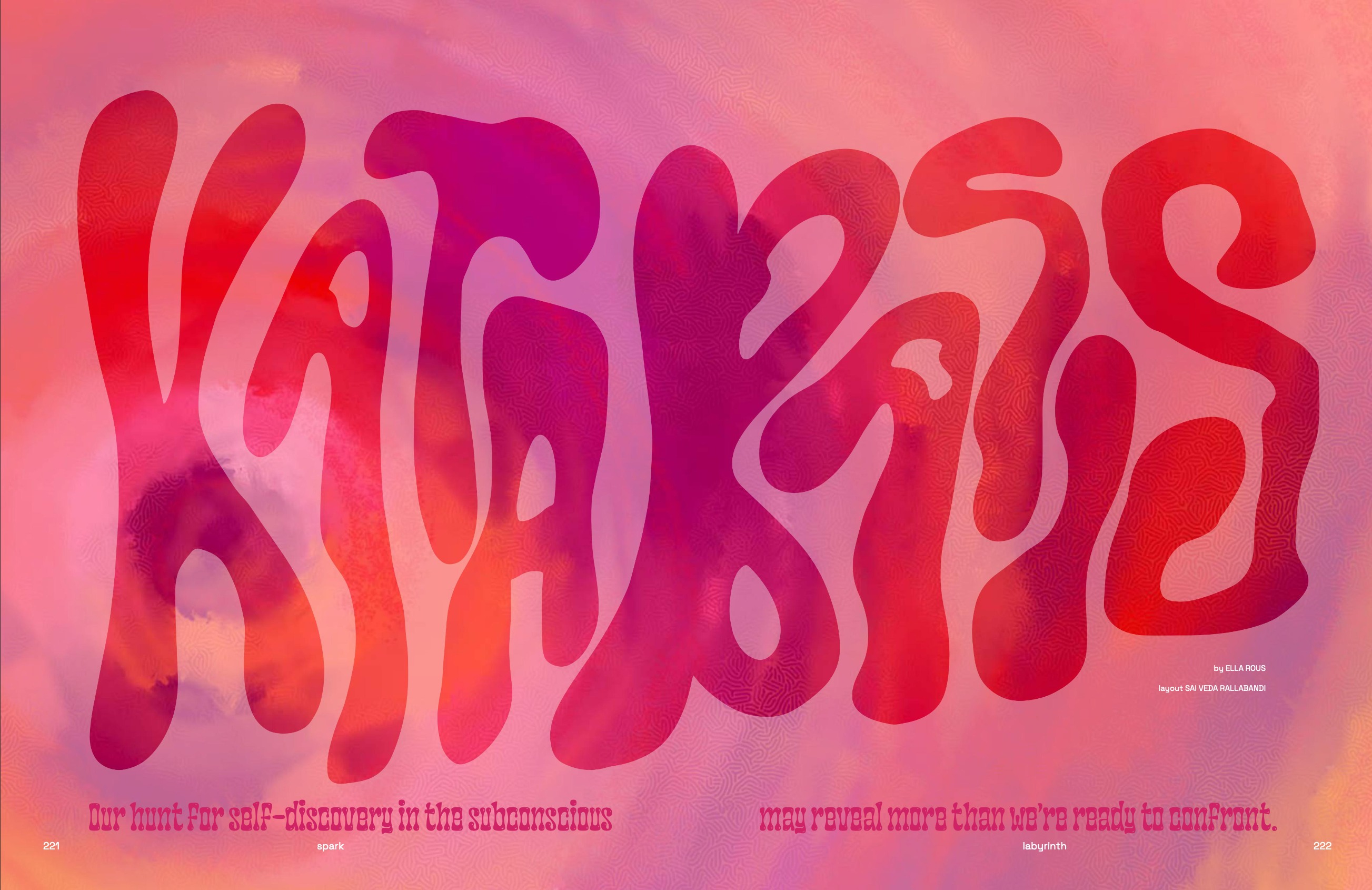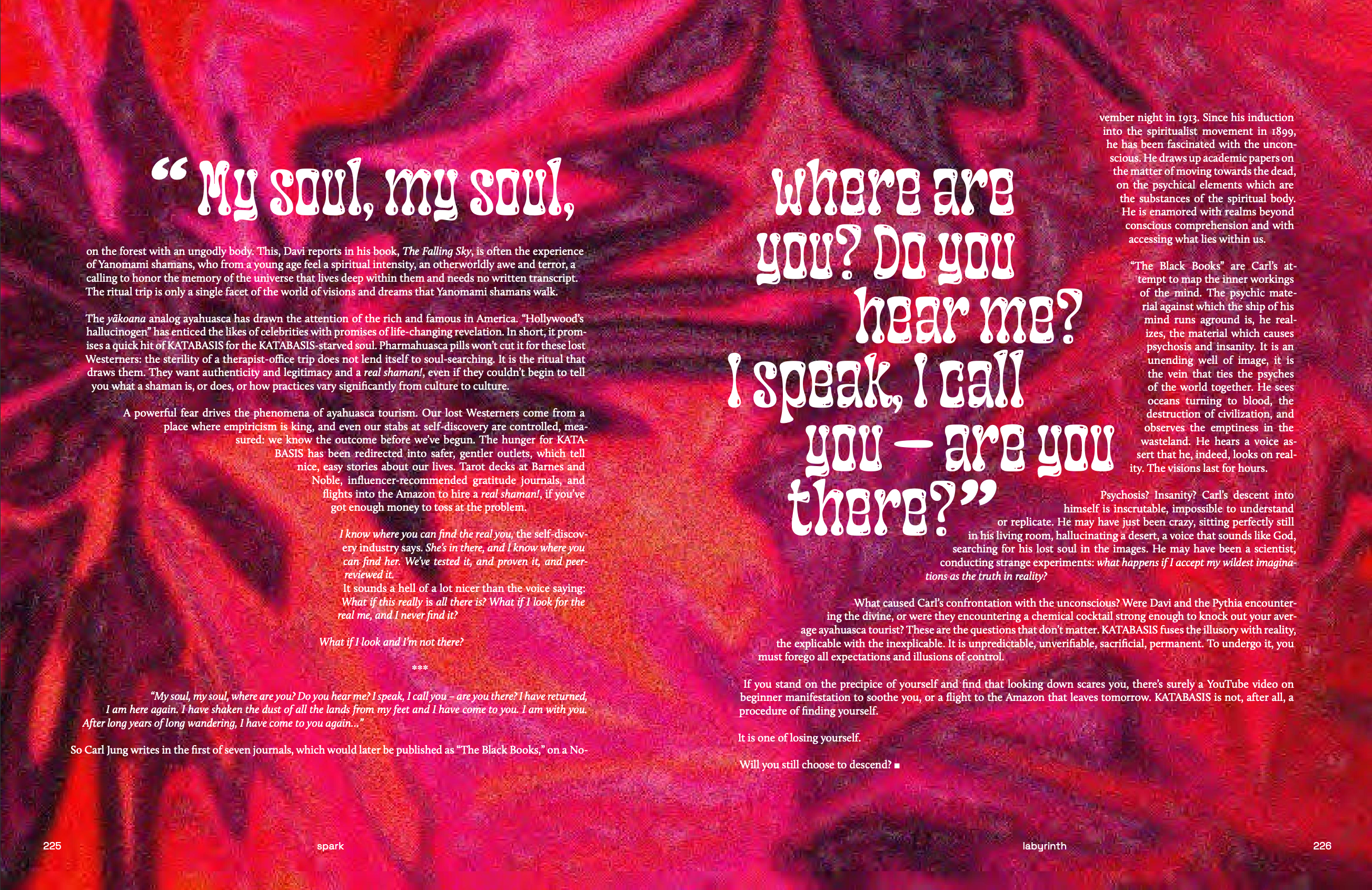KATABASIS

| Our hunt for self-discovery in the subconscious may reveal more than we’re ready to confront. |
The Pythia descends.
She must step carefully across the fissure-stricken dirt floor of the chamber beneath the temple of Delphi. The powerful fumes rising from a massive tear in the soft Earth are attributed to Apollo’s slaying of the legendary Python; to the massive snake’s slow decomposition at the bottom of the pit.
As she inhales the fumes, she begins to sway on the tripod stool that balances over the chasm. Her eyelashes flutter madly, her lips open and close like a dying fish, and she chants fervently. At last, she falls still. She has spoken with the tongue of the gods.
The Pythia’s power is not intrinsic, but rather granted through the intricate procedures that foreground the moment of possession. It is the submersion in the Cassian springs, the slaughter of the baby goat, and, probably, the inhalation of dangerous amounts of ethane that allow for the god Apollo to inhabit an unremarkable mortal body.
For a single moment, her skin was a vessel for holding godhood. Her body grew in size, her hair stood on end. Time collapsed in her hands, allowing her access to the past as well as the future. Her mind, omniscient and all-powerful, expanded rapidly, nearly shattering in the process of pressing against its mortal bound.
Physically spent, she collapses. The singular strength it required to host a god within her has shaved a year from her lifespan, but her mind dances in exhausted ecstasy. She has come back from the land of the extraordinary bearing strange gifts.
This is the oldest story there is.
Scholar Joseph Campbell’s monomyth is the formula for every hero’s making: the figures of myth, legend, folklore, and religious canon. It depicts the procedure following the hero’s descent into the world of the unnatural and sublime, and the subsequent journey back to the mundane world with untold wisdom and self-understanding. These narratives (Gilgamesh, Orpheus, Dante, Muhammad, King Arthur) form the canon of humanity’s favorite story. It is a story of descent and discovery, of other planes and places that are not here. This is KATABASIS.

The human desire for descent exceeds (or perhaps, provokes) our storytelling compulsions. KATABASIS, conceptually, eclipses the literary structure and its underworld destination: it’s the movement of our intellects to places that are unfamiliar, powerful, and raw. Our hunger to let loose our souls and engulf our tired lives in enlightenment has long guided the stories we tell about what we’re made of.
We have an intuition that our selves are not really our selves; that we connect with the real world through a conduit or medium that is a constructed artifice. It seems that the realm of the extraordinary is less interesting to us than the journey there, the procedures involved in invoking it. We’re looking for ourselves underneath ourselves, the heart within the heart. We’re tracking the ghostly flit of the true self across the subconscious.
***
In the Amazon basin, Davi Kopenawa Yanomami imbibes the yãkoana powder and becomes spirit.
As he sits among the towering trunks of the rainforest, watching the sun disappear below the horizon, a strangeness comes over the world. In the distance, a lilting hum rises on the wind. Small, tremulous lights, like pinpricks in the fabric of the night sky, begin to come into focus. These anthropomorphic forms, called xapiripë, are microscopic. They are the spirits of toucans and hummingbirds, moka frogs and bat people. Under the revelatory power of the yãkoana powder, they come to dance for Davi. “My soul began to shine,” Davi says reverently of his first experience partaking. “All came and slung their hammocks in my chest.”
As a child, Davi became ghost as he slept, crying and thrashing, possessed by otherworldly dimensions. He grew huge and weightless as the xapiripë carried his image into the heavens so that he could look down on the forest with an ungodly body. This, Davi reports in his book, The Falling Sky, is often the experience of Yanomami shamans, who from a young age feel a spiritual intensity, an otherworldly awe and terror, a calling to honor the memory of the universe that lives deep within them and needs no written transcript. The ritual trip is only a single facet of the world of visions and dreams that Yanomami shamans walk.
The yãkoana analog ayahuasca has drawn the attention of the rich and famous in America. “Hollywood’s hallucinogen” has enticed the likes of celebrities with promises of life-changing revelation. In short, it promises a quick hit of KATABASIS for the KATABASIS-starved soul. Pharmahuasca pills won’t cut it for these lost Westerners: the sterility of a therapist-office trip does not lend itself to soul-searching. It is the ritual that draws them. They want authenticity and legitimacy and a real shaman!, even if they couldn’t begin to tell you what a shaman is, or does, or how practices vary significantly from culture to culture.
A powerful fear drives the phenomena of ayahuasca tourism. Our lost Westerners come from a place where empiricism is king, and even our stabs at self-discovery are controlled, measured: we know the outcome before we’ve begun. The hunger for KATABASIS has been redirected into safer, gentler outlets, which tell nice, easy stories about our lives. Tarot decks at Barnes and Noble, influencer-recommended gratitude journals, and flights into the Amazon to hire a real shaman!, if you’ve got enough money to toss at the problem.
I know where you can find the real you, the self-discovery industry says. She’s in there, and I know where you can find her. We’ve tested it, and proven it, and peer-reviewed it.
It sounds a hell of a lot nicer than the voice saying: What if this really is all there is? What if I look for the real me, and I never find it?
What if I look and I’m not there?
***
“My soul, my soul, where are you? Do you hear me? I speak, I call you – are you there? I have returned, I am here again. I have shaken the dust of all the lands from my feet and I have come to you. I am with you. After long years of long wandering, I have come to you again…”

So Carl Jung writes in the first of seven journals, which would later be published as “The Black Books,” on a November night in 1913. Since his induction into the spiritualist movement in 1899, he has been fascinated with the unconscious. He draws up academic papers on the matter of moving towards the dead, on the psychical elements which are the substances of the spiritual body. He is enamored with realms beyond conscious comprehension and with accessing what lies within us.
“The Black Books” are Carl’s attempt to map the inner workings of the mind. The psychic material against which the ship of his mind runs aground is, he realizes, the material which causes psychosis and insanity. It is an unending well of image, it is the vein that ties the psyches of the world together. He sees oceans turning to blood, the destruction of civilization, and observes the emptiness in the wasteland. He hears a voice assert that he, indeed, looks on reality. The visions last for hours.
Psychosis? Insanity? Carl’s descent into himself is inscrutable, impossible to understand or replicate. He may have just been crazy, sitting perfectly still in his living room, hallucinating a desert, a voice that sounds like God, searching for his lost soul in the images. He may have been a scientist, conducting strange experiments: what happens if I accept my wildest imaginations as the truth in reality?
What caused Carl’s confrontation with the unconscious? Were Davi and the Pythia encountering the divine, or were they encountering a chemical cocktail strong enough to knock out your average ayahuasca tourist? These are the questions that don’t matter. KATABASIS fuses the illusory with reality, the explicable with the inexplicable. It is unpredictable, unverifiable, sacrificial, permanent. To undergo it, you must forego all expectations and illusions of control.
If you stand on the precipice of yourself and find that looking down scares you, there’s surely a YouTube video on beginner manifestation to soothe you, or a flight to the Amazon that leaves tomorrow. KATABASIS is not, after all, a procedure of finding yourself.
It is one of losing yourself.
Will you still choose to descend? ■
Layout: Sai Veda Rallabandi
Other Stories in Labyrinth
© 2024 SPARK. All Rights Reserved.
